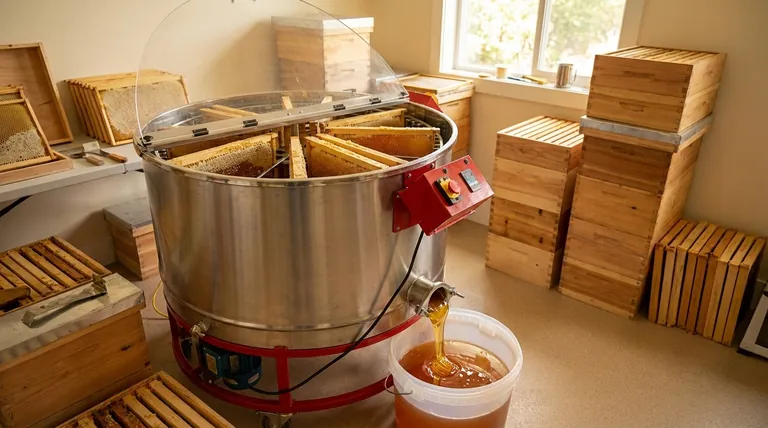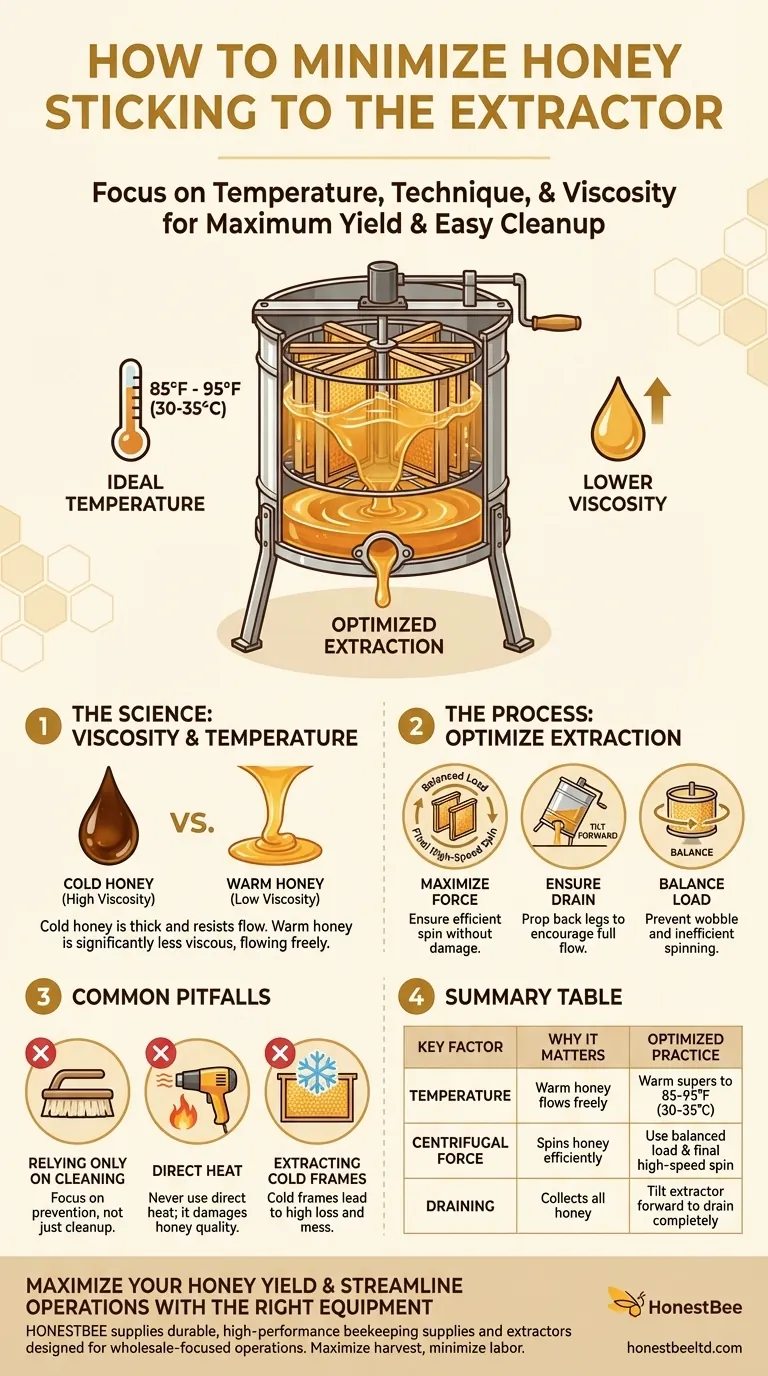To minimize honey sticking to your extractor, the single most effective strategy is to extract when the honey is warm. Warm honey is significantly less viscous, allowing it to flow freely from the comb and drain completely from the extractor walls. While proper draining and spinning technique are important, managing temperature is the fundamental solution.
The core issue is honey's viscosity—its thickness and resistance to flow. Instead of focusing solely on cleaning up the sticky residue after the fact, the goal should be to reduce the honey's viscosity during the extraction process itself, primarily through warmth.

The Physics of a Clean Extraction
Honey that sticks to the extractor is honey that is too thick, or viscous, to be fully pulled out by centrifugal force. Understanding and managing this property is the key to both maximizing your harvest and simplifying your cleanup.
Understanding Honey Viscosity
Honey's thickness is not a fixed property. It changes dramatically with temperature. Cold honey is thick like molasses, while warm honey flows easily, almost like syrup. This is the primary lever you can pull to influence how much honey is left behind.
The Critical Role of Temperature
The ideal temperature for honey extraction is between 85°F and 95°F (30-35°C). At this temperature, the honey's viscosity drops significantly.
Bringing your honey supers into a warm room for 24-48 hours before you begin extracting allows the honey to warm through to the core of the frames. This simple preparatory step will have a bigger impact than any other part of your technique.
Optimizing Your Extraction Process
Once the honey is warm, your technique ensures you get the most out of it. Centrifugal force must be applied correctly to overcome the honey's natural adhesion to the comb.
Maximize Centrifugal Force
The extractor works by spinning frames to sling the honey out. Ensure you are spinning the frames long enough and fast enough (without damaging the comb) to extract the maximum amount. Start slow to avoid blowouts, then gradually increase the speed for a final, powerful spin.
Ensure a Full and Final Drain
Once you've finished spinning, the honey will pool at the bottom. Tilt the extractor forward, propping up the back legs on a block of wood. This slight angle encourages the remaining honey to flow towards the honey gate for collection, minimizing what's left behind.
The Importance of a Balanced Load
An unbalanced extractor will wobble violently, preventing it from reaching optimal speed. This inefficient spin leaves a significant amount of honey in the frames and results in a messier process. Always balance the load by placing frames of similar weight opposite each other.
Common Pitfalls to Avoid
Many beekeepers accept a sticky extractor as inevitable, but this is often due to a misunderstanding of the process.
Mistake 1: Relying Only on Cleaning
Cleaning is for sanitation, not for harvesting. While you must clean your equipment thoroughly with water after use, your goal should be to minimize the amount of honey that needs to be washed away in the first place. Prevention through warmth is far more effective.
Mistake 2: Applying Direct Heat
Never apply direct heat to your extractor or honey with a heat gun or torch. Overheating can destroy the beneficial enzymes in honey, alter its flavor, and increase its HMF levels, which degrades quality. Gentle, ambient room warmth is the correct approach.
Mistake 3: Extracting Cold Frames
Pulling frames directly from a cool hive or a cold garage and putting them into the extractor is the most common cause of a sticky mess. This "cold extraction" guarantees high honey loss and a difficult cleanup.
Making the Right Choice for Your Goal
By focusing on the right variables, you can tailor your process to meet your specific needs.
- If your primary focus is maximizing honey yield: Pre-warming your supers in a heated room is the most important step you can take.
- If your primary focus is saving time and effort: A warm extraction will drastically reduce cleanup, as less honey will be left behind to scrub.
- If your primary focus is protecting your equipment: Always ensure your frame load is balanced to achieve an efficient spin and prevent damaging the extractor's bearings.
Ultimately, a successful and clean extraction comes from working with honey's physical properties, not fighting against them.
Summary Table:
| Key Factor | Why It Matters | Optimal Practice |
|---|---|---|
| Temperature | Warm honey is less viscous and flows freely. | Warm supers to 85-95°F (30-35°C) before extracting. |
| Centrifugal Force | Spins honey out of the comb efficiently. | Use a balanced load and a final high-speed spin. |
| Draining | Collects all honey from the extractor. | Tilt the extractor forward after spinning to drain completely. |
Maximize your honey yield and streamline your operation with the right equipment.
As a commercial beekeeper or distributor, efficiency is paramount. HONESTBEE supplies durable, high-performance beekeeping supplies and extractors designed for wholesale-focused operations. Our equipment helps you achieve the clean, efficient extractions described in this article, maximizing your harvest and minimizing labor.
Contact HONESTBEE today to discuss how our wholesale solutions can benefit your apiary or distribution business.
Visual Guide

Related Products
- HONESTBEE 72 Frame Industrial Electric Honey Extractor for Beekeeping
- 6 Frame Manual Stainless Steel Honey Extractor Beekeeping Equipment
- 40 Frame Commercial Electric Honey Extractor for Beekeeping
- HONESTBEE 6 Frame Three Use Electric Honey Extractor for Beekeeping
- Plastic Hand Crank 2 Frame Honey Extractor Low Price
People Also Ask
- Can a manual extractor be upgraded to an electric one? Save Labor & Boost Efficiency
- What are the advantages of automated honey extractors in terms of time efficiency? Boost Your Harvest Speed
- How is honey harvested from Langstroth hives? A Guide to Efficient, Comb-Preserving Extraction
- What are the advantages of automatic honey extractors? Scale Your Apiary with Unmatched Efficiency
- What is the energy consumption like for automatic honey extractors? Maximize Your Harvest Efficiency



















